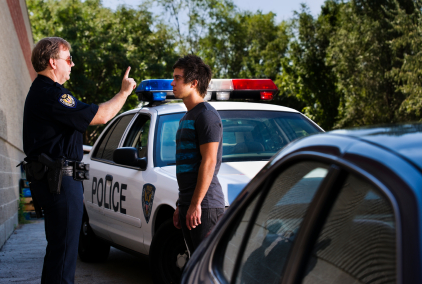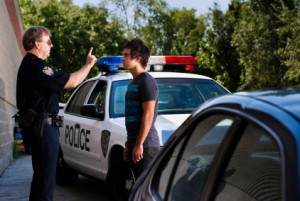According to the National Highway Traffic Safety Administration, there are 24 main clues that police officers use to detect impaired drivers while the vehicle is in motion. These clues were developed from data of road side stops and have been found to be the most common visual predictors of an impaired driver.
Driving under the influence (DUI) is very dangerous, and as you will see by the following list of clues that police officers use, the effects on one’s driving can be openly visible and detected.
PROBLEMS WITH MAINTAINING PROPER LANE POSITION:
An impaired driver’s perception and vision are altered, so many often experience problems with maintaining their lane position. The following are some of the more common problems with maintaining proper lane position that are potential clues for law enforcement officers to detect that the driver might be driving under the influence.
1)    Weaving – Weaving within your lane is a strong clue for DUI. If you are not in full control of the steering wheel and your vehicle is alternately moving from one side of the lane to the other in a zigzag pattern, then you will be easily detected by law enforcement as a potential DUI.
2)Â Â Â Â Weaving Across Lane Lines – Weaving across the lane lines is when your vehicle is going over your lane lines and into the lanes next to you.
3)Â Â Â Â Straddling a Lane Line – When your vehicle is moving straight ahead, but your car is straddling over the lane marker in a way that you are driving in two lanes.
4)    Swerving – A swerve is an abrupt turn away from a generally straight course. Impaired drivers are prone to swerving because they cannot focus on controlling the vehicle.
5)    Turning With a Wide Radius – During a turn, the radius is defined by the distance between the turning vehicle and the center of the turn. If the curve of the turn is greater than normal then it is too wide to be safe for the road.
6)Â Â Â Â Drifting – Drifting is when the car is moving forward but is slightly angled and not driving parallel to the lane. Â Drifting might be observed within a single lane, across lanes, across the center line, onto the shoulder, and from lane to lane.
7)    Almost Striking an Object or Vehicle – Almost striking a stationary object or another moving vehicle is a major DUI signal for law enforcement. Examples include: passing abnormally close to a sign, wall, building, or other object; passing abnormally close to another moving vehicle; and causing another vehicle to maneuver to avoid collision.
SPEED AND BRAKING PROBLEMS:
A common problem with impaired drivers is that their speed levels are unusually high or low and they have trouble with making proper stops. So, law enforcement officers keep an eye out for strange patterns in speed and for drivers who are having trouble with their stops. The following are some of the more common speed and braking problems that are easy clues for DUI.
8)    Stopping (Braking) Problems – Stopping too far from a curb or at an inappropriate angle. Stopping too short or beyond limit line at an intersection. Stopping with a jerking motion or abruptly. These are a few examples of the braking problems that are common indicators of an impaired driver.
9)    Accelerating or Decelerating Rapidly – Any acceleration or deceleration that is significantly more rapid than that required by the traffic conditions. Rapid acceleration might be accompanied by breaking traction; rapid deceleration might be accompanied by an abrupt stop. Also a vehicle might alternately accelerate and decelerate rapidly. Any combination of these things will signal to police officers to observe for DUI.
10) Varying Speed – Alternating between speeding up and slowing down.
11) Driving Too Slowly for Posted Speed Limit – Driving too slowly can be just as dangerous as speeding. It is also a clue that the driver may be driving while impaired. Law enforcement will be watching for vehicles that are being driven too slowly (about 10 MPH, or more, below the posted speed limit).
ATTENTION PROBLEMS:Â
Not paying attention while you are driving is one of the most dangerous things you can do, whether or not you are driving while impaired. Even a sober driver who does not pay attention can experience the following effects of not paying attention while driving. The following are some of the more common attention problems that are potential clues for DUI.
12) Driving In Opposing Lanes or Going the Wrong Way on a One-Way Street – The vehicle is observed heading into opposing or crossing traffic. For example: driving in the opposing lane; backing into traffic; failing to yield the right-of-way; and driving the wrong way on a one-way street.
13) Slow Response to Traffic Signals – An impaired driver’s response time is delayed, so law enforcement officers keep a lookout for drivers with slower response time to signals. For example, when the observed vehicle exhibits a longer than normal response to a change in traffic signal and the driver remains stopped at the intersection for an abnormally long period of time after the traffic signal has turned green. This is a DUI clue for the police.
14) Slow or Failure to Respond to Officer’s Signals – Also, if the driver is unusually slow to respond to an officer’s lights, siren or hand signals, it can signal to the officer that the driver is somehow impaired.
15) Stopping in Lane for No Apparent Reason – The critical element in this clue is that there is no observable justification for the vehicle to stop in the traffic lane; the stop is not caused by traffic conditions, traffic signals, an emergency situation, or related circumstances.  Impaired drivers might stop in the lane when their capability to interpret information and make decisions becomes impaired. As a consequence, stopping in lane for no apparent reason is likely to occur at intersections or other decision points.
16) Driving Without Headlights At Night – When the observed vehicle is being driven with both headlights off during a period of the day when the use of headlights is required, it is a clue for police officers that the driver is impaired. Impaired drivers are careless and unaware of their surroundings and when they do not do the things they are supposed to do when driving under certain conditions, it is easy to spot.
17) Failure to Signal or Signal Inconsistent with Action – Another good example of impaired drivers being careless and not doing what they are supposed to do is failing to use their signals or signaling incorrectly. Â For example, signaling opposite to the turn or lane change executed; signaling constantly with no accompanying driving action; failing to signal a turn or lane change; and driving with four-way hazard flashers on.
JUDGMENT PROBLEMS:
An impaired driver’s judgment is very poor. They have difficulty making decisions, they sometimes stall, or they act quickly and without warning. Police officers understand how substances can affect a driver’s judgment and they know what to look for. The following are some of the more common judgment problems that are easy clues for DUI.
Â
18) Following Too Closely – The vehicle is observed following another vehicle while not maintaining the legal minimum separation. Following too closely behind the car in front of you is very dangerous. An impaired driver may not realize they are even doing it.
19) Improper or Unsafe Lane Change – When the driver is frequently or abruptly changing lanes without regard to other motorists, the driver is taking risks and endangering others.
20) Illegal or Improper Turn – When the driver executes any turn that is abnormally abrupt or illegal, such as turning with excessive speed; turning sharply from the wrong lane; making an illegal U-turn; or turning from outside a designated turn lane.
21) Driving on Paths Other Than the Designated Roadway – The vehicle is observed being driven on paths other than the roadway designated for traffic movement, such as at the edge of the roadway, on the shoulder, off the roadway entirely, and straight through turn-only lanes or areas.
22) Stopping Inappropriately in Response to Officer – All drivers naturally become a little nervous when an officer signals them to stop on the side of the road, but an impaired driver’s responses can vary greatly from the average driver’s response. An impaired driver might stop the car at an inappropriate location or under inappropriate conditions, such as other than in the traffic lane. Other examples include stopping: in a prohibited zone; at a crosswalk; far short of an intersection; on a walkway; across lanes; for a green traffic signal; for a flashing yellow traffic signal; abruptly as if startled; or in an illegal, dangerous manner.
23) Inappropriate or Unusual Behavior “ An impaired driver is not going to act like the average driver. They usually display unusual or inappropriate behaviors. They often say the wrong thing or do the wrong thing. If an officer finds a driver throwing objects from the vehicle, drinking in the vehicle, urinating at the roadside, arguing without cause, or displaying other disorderly actions, this will be a strong indication of DUI.
24) Appearing to be Impaired – This clue is actually one or more of a set of indicators related to the personal behavior or appearance of the driver. Examples of specific indicators might include:
- Eye fixation
- Tightly gripping the steering wheel
- Slouching in the seat
- Gesturing erratically or obscenely
- Face close to the windshield
- Driver’s head protruding from vehicle
At A. Bishop Law, our Georgia DUI Lawyer understands the importance of appealing the Notice of Intent to Suspend and the impact it can have on the Georgia DUI Criminal Defense case.
Our Georgia Criminal Defense Attorneys welcome any questions on Criminal Defense and Georgia DUI laws. Please Call or Email us about any questions you may have about GA DUI laws in Georgia and please remember your initial consultation is free of charge.
About the attorney:  Anne Bishop is a Georgia Lawyer with A. Bishop Law in Gainesville, Georgia and handles various DUI / DWI, Marijuana Arrests and other Georgia Criminal Defense matters.  The law office of A. Bishop Law can assist clients throughout Georgia including: Hall County (Gainesville, Oakwood, Flowery Branch), Jackson County  (Jefferson, Braselton) White County (Helen, Cleveland), Lumpkin County (Dahlonega), Dawson County (Dawsonville), Habersham County (Demorest, Cornelia), and all of Northeast Georgia.
This article and/or video should not be considered nor relied upon as legal advice since it is only intended for general overview and informational purposes. Please consult with an attorney on your specific situation in order to determine an appropriate legal course of action.





